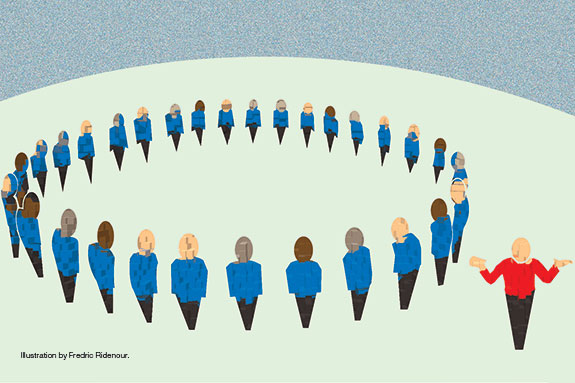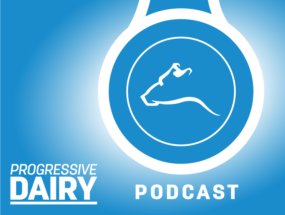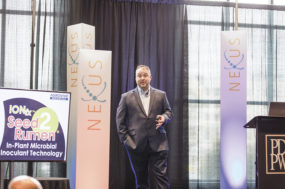“We had just dispersed from taking a staff photo of all our dairy’s employees – no small feat given the different shifts that we have and everyone showing up to work on time. It wasn’t until after the photo that I realized everyone was wearing new company shirts we had purchased – except for one of our newer employees. I knew he would stand out in the photo like a sore thumb, but he hadn’t said anything to me. Then I wondered if he thought I was punishing him because after a few days on the job, he had caused $1,400 in damage to one of our tractors. He said he could operate heavy machinery when he applied. I soon learned he wasn’t as skilled as he said he was. Not giving him a company shirt was purely an oversight; we had ordered him one. Should I give him the sweatshirt now? Or should I just let him think I’m punishing him? What should I do?”

Expert 1
Felix Soriano, MS, PAS APN Consulting, LLC
First and foremost, I would strongly encourage you to give him the shirt he should have gotten before the picture was taken right away – and apologize for not having done so earlier. You need to promote the culture of your dairy right from the get-go as you hire new employees. Having a company shirt is a small but important part of making employees feel proud of where they work.
Second, I would advise you to improve or re-evaluate the hiring and training process of new employees since, as you clearly mentioned, you as a manager failed to better assess your new employee’s true skills and his knowledge of the work he was hired to do.
This is a very important (if not the most important) role of any manager. Hiring the right people for the right job leads to more profits, better performance and more efficiency in any business – and the dairy business is no different.
Bottom line: After giving your new employee his shirt, I suggest you start working on your hiring process – recruiting, what questions to ask, how to assess skills, etc. Second, re-evaluate your orientation and training program for new employees.
First impressions and first experiences at a new job are critical to the longevity and success of a new employee at a new job. During this time people are more receptive, more open to learning and eager to excel at their jobs. Take advantage of this and properly train employees to reduce accidents and costly mistakes that can jeopardize that new employee’s success at your dairy.

Expert 2
Orlando Gil TCTS Global, LLC

It sounds as if you have good intentions when it comes to managing your employees. The fact that you scheduled a staff photo with all employees wearing company shirts is commendable. One would think that having a “staff photo” would help build rapport and encourage a team environment – perhaps the reason for this activity. One must ask, however: How much planning and attention to details went into having this event? Not all employees had the new shirts.
You mention this being “an oversight” and shift the responsibility to the new employee not getting a shirt since he did not say anything to you … is it possible the new employee may have thought he would have come across as overly demanding since he had just recently started working at your operation?
Is it possible the work environment is such that the new employee was afraid of asking? I guess it is possible the employee thought he was being punished for the damage he caused one of the tractors, but if this is the case, it is doubtful this individual will remain at your operation for very long.
Before suggesting what you should do, one must ask: Is there a structured process that new employees must go through as they join the operation – from interviewing with pre-determined and well-thought-out questions to doing reference checks – before making an offer?
Is there a new employee orientation that includes setting training goals and scheduling evaluations of performance? Is there a specific individual responsible for training and developing new employees to reach a certain level of performance before allowing them to “solo”? Are employees viewed as “investments” or as costs in your operation?
Your answers to these questions will give you several ideas as to what you should do next …

Expert 3
Tom Wall
Dairy Interactive, LLC
Give him the shirt and tell him the truth. Unfortunately, the tractor damage is already done and the team picture is already taken. But more than anything, these two things are completely separate and independent of each other.
That being said, chances are your “scorned” employee probably took this “no shirt for you” incident personally and thinks you did it on purpose.
So, first things first … if you want this employee to stay and give you his best effort in the future, I’d also explain that the “missing shirt” was an honest mistake with bad timing. I’d say something like this … “You’re probably thinking that I didn’t give you a shirt on purpose … but that’s not what happened and I wanted you to know that. Yeah, we were upset about the tractor damage … but that had nothing to do with the shirt and the photo.”
And one more thing … if you do team meetings, I’d give everyone a copy of the photo and then apologize to the “shirtless” employee in front of his co-workers so they all know that you simply forgot to give him his shirt before taking the picture.
Why the public apology/explanation? The only thing worse than being in trouble with the boss is listening to co-workers gossip about being in trouble with the boss. (And yes, the “he’s getting fired” rumor gets spread a lot more than you might think.)
When it comes to employee management (especially involving disciplinary action), it’s important you show your employees that all actions (good and bad) have outcomes. If you focus on doing that consistently, your team will know what to expect and realize that nothing you do is ever personal. PD
Click here to submit your own employee relations questions for the panel to review.







